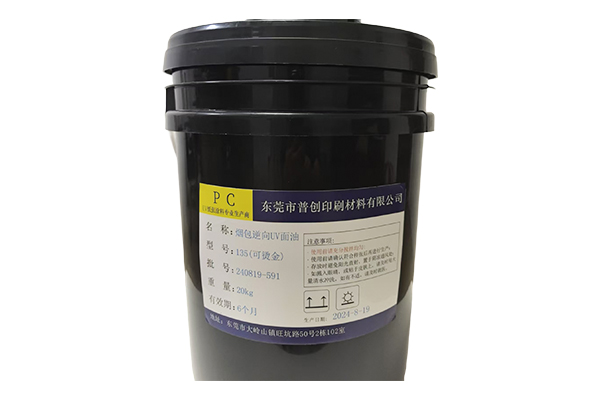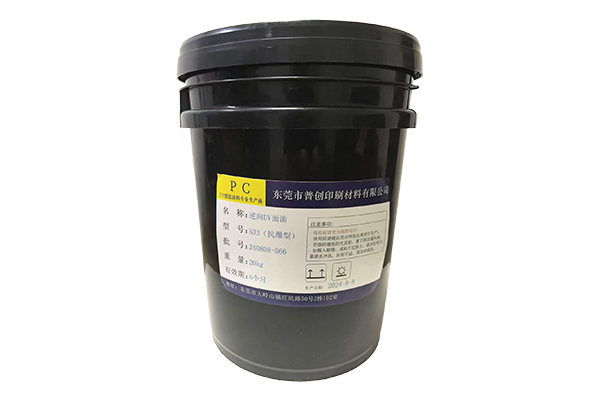How does reverse uv varnish achieve special matte and highlight contrast effects compared to ordinary UV varnish?
Release Time : 2025-02-13
Reverse uv varnish and ordinary UV varnish achieve special matte and highlight contrast effects mainly through their unique process and principle.
1. Overview of reverse uv varnish process
The reverse uv varnish process is an advanced printing process relative to traditional local varnishing. It uses light-curing UV technology to form printed products with the same or similar quality as traditional UV inks on the surface of printed products, but further, it can achieve mirror high-gloss effects and matte or hemp-like non-high-gloss effects on the same printed product through special processes. This process has been widely used in printing plants in Europe and the United States, and is favored because it can produce high printing contrast effects.
2. The principle of reverse uv varnish to form contrast effects
Combination of local varnishing and local frosting: The reverse uv varnish process adopts local varnishing to apply UV varnish in areas where high-gloss effects are required. At the same time, special frosting or matte treatment is used in non-high-gloss areas to form a matte or pockmarked effect.
Cohesive reaction between varnish and reverse ink: In the reverse uv varnish process, the varnish and the previously applied reverse ink produce a cohesive reaction in the contact area to form a small granular ink film. This reaction forms a matte or pockmarked effect in non-high-gloss areas, while the high-gloss areas without reverse ink maintain a mirror-like high-gloss effect.
3. The difference between reverse uv varnish and ordinary UV varnish
Effect comparison: Ordinary UV varnish mainly forms a high-gloss effect, increasing the brightness and clarity of the printed product.
Reverse uv varnish can achieve both high-gloss and matte effects on the same printed product, forming a strong visual contrast.
Process complexity: The ordinary UV varnish process is relatively simple, mainly relying on the curing of UV light and the uniform coating of varnish.
The reverse uv varnish process is more complicated, requiring precise control of the distribution of the glazing area and the frosted area, as well as the cohesive reaction between the varnish and the reverse ink.
Application scenarios: Ordinary UV varnish is suitable for printing that needs to increase gloss and wear resistance. Reverse uv varnish is more suitable for printed materials such as packaging and advertising that require strong visual contrast and high-quality texture.
4. Advantages of reverse uv varnish
Enhance visual effects: Reverse uv varnish can form a sharp contrast between matte and highlight on printed materials, enhancing the visual effect and attractiveness of the product.
Improve product texture: Through the combination of local matte and local highlight, reverse uv varnish can enhance the overall texture and grade of the product.
Increase light resistance and moisture resistance: The reverse uv varnish process can also enhance the light resistance and moisture resistance of the ink, playing a role in protecting the imprint and beautifying the product.
In summary, reverse uv varnish achieves a strong contrast effect between gloss and matte on the same printed product through its unique process principle of combining local glazing and local frosting. This effect not only enhances the visual effect and texture of the product, but also improves the light resistance and moisture resistance of the ink. Compared with ordinary UV varnish, reverse uv varnish has more advantages in application scenarios and process complexity.
1. Overview of reverse uv varnish process
The reverse uv varnish process is an advanced printing process relative to traditional local varnishing. It uses light-curing UV technology to form printed products with the same or similar quality as traditional UV inks on the surface of printed products, but further, it can achieve mirror high-gloss effects and matte or hemp-like non-high-gloss effects on the same printed product through special processes. This process has been widely used in printing plants in Europe and the United States, and is favored because it can produce high printing contrast effects.
2. The principle of reverse uv varnish to form contrast effects
Combination of local varnishing and local frosting: The reverse uv varnish process adopts local varnishing to apply UV varnish in areas where high-gloss effects are required. At the same time, special frosting or matte treatment is used in non-high-gloss areas to form a matte or pockmarked effect.
Cohesive reaction between varnish and reverse ink: In the reverse uv varnish process, the varnish and the previously applied reverse ink produce a cohesive reaction in the contact area to form a small granular ink film. This reaction forms a matte or pockmarked effect in non-high-gloss areas, while the high-gloss areas without reverse ink maintain a mirror-like high-gloss effect.
3. The difference between reverse uv varnish and ordinary UV varnish
Effect comparison: Ordinary UV varnish mainly forms a high-gloss effect, increasing the brightness and clarity of the printed product.
Reverse uv varnish can achieve both high-gloss and matte effects on the same printed product, forming a strong visual contrast.
Process complexity: The ordinary UV varnish process is relatively simple, mainly relying on the curing of UV light and the uniform coating of varnish.
The reverse uv varnish process is more complicated, requiring precise control of the distribution of the glazing area and the frosted area, as well as the cohesive reaction between the varnish and the reverse ink.
Application scenarios: Ordinary UV varnish is suitable for printing that needs to increase gloss and wear resistance. Reverse uv varnish is more suitable for printed materials such as packaging and advertising that require strong visual contrast and high-quality texture.
4. Advantages of reverse uv varnish
Enhance visual effects: Reverse uv varnish can form a sharp contrast between matte and highlight on printed materials, enhancing the visual effect and attractiveness of the product.
Improve product texture: Through the combination of local matte and local highlight, reverse uv varnish can enhance the overall texture and grade of the product.
Increase light resistance and moisture resistance: The reverse uv varnish process can also enhance the light resistance and moisture resistance of the ink, playing a role in protecting the imprint and beautifying the product.
In summary, reverse uv varnish achieves a strong contrast effect between gloss and matte on the same printed product through its unique process principle of combining local glazing and local frosting. This effect not only enhances the visual effect and texture of the product, but also improves the light resistance and moisture resistance of the ink. Compared with ordinary UV varnish, reverse uv varnish has more advantages in application scenarios and process complexity.






